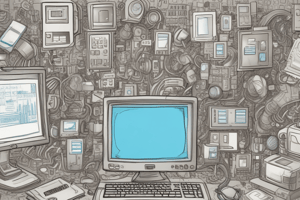Podcast
Questions and Answers
What was used to load the remainder of the operational software in early home computers like the Acorn BBC B?
What was used to load the remainder of the operational software in early home computers like the Acorn BBC B?
- Hard disk drive
- Cassette tape machine (correct)
- Punched cards
- Paper tape
What is the primary function of an operating system?
What is the primary function of an operating system?
- To store the BIOS configuration
- To control the hardware components of a computer
- To provide a command line interface only
- To provide a useable interface between humans and computer, and an environment for applications to run (correct)
What is an advantage of using Command Line Interface (CLI)?
What is an advantage of using Command Line Interface (CLI)?
- Easy to learn and use for beginners
- Allows the user to be in direct communication with the computer (correct)
- Provides a limited number of pre-determined options
- Allows the user to interact with the computer using pictures or symbols
What type of memory is used to store the BIOS configuration?
What type of memory is used to store the BIOS configuration?
What is the primary function of a windows manager?
What is the primary function of a windows manager?
Why is not all of the operating system loaded into RAM at once?
Why is not all of the operating system loaded into RAM at once?
What is a characteristic of post-WIMP interaction?
What is a characteristic of post-WIMP interaction?
What is an alternative to the graphical user interface (GUI)?
What is an alternative to the graphical user interface (GUI)?
What is a feature of modern computer systems?
What is a feature of modern computer systems?
What is an example of a GUI environment?
What is an example of a GUI environment?
Flashcards are hidden until you start studying
Study Notes
Early Computing and Operating Systems
- Early computers had no operating system and required control software to be loaded each time they were started using paper tape or punched cards.
- In the 1970s, home computers like the Acorn BBC B used an internal ROM chip to store part of the operating system and a cassette tape machine to load the remainder.
Development of Operating Systems
- With the development of hard disk drives (HDD), operating systems were stored on the hard disk, and start-up of the motherboard was handled by the basic input/output system (BIOS).
- The BIOS contents are stored on a flash memory chip, and its configuration is stored in CMOS memory, allowing it to be altered or deleted as required.
Functions of Operating Systems
- An operating system provides an environment for applications to run and a usable interface between humans and computers.
- It disguises the complexity of computer hardware and provides a human-computer interface (HCI) through a graphical user interface (GUI) or command line interface (CLI).
Human-Computer Interface (HCI)
- A GUI allows users to interact with computers using pictures or symbols (icons) and provides various technologies and devices for the user interface.
- One of the first commonly used GUI environments was WIMP (windows, icons, menu, and pointing device), which was developed for personal computers.
- Modern computer systems allow multiple windows to be open at the same time, and a window manager looks after the interaction between windows, applications, and the windowing system.
Evolution of HCI
- Smartphones, tablets, and many computers now use post-WIMP interaction, where fingers are in contact with the screen, allowing actions such as pinching and rotating.
- Touch screen technology has made flexible HCIs readily available, allowing users to launch applications by simply tapping icons on the screen.
Studying That Suits You
Use AI to generate personalized quizzes and flashcards to suit your learning preferences.




